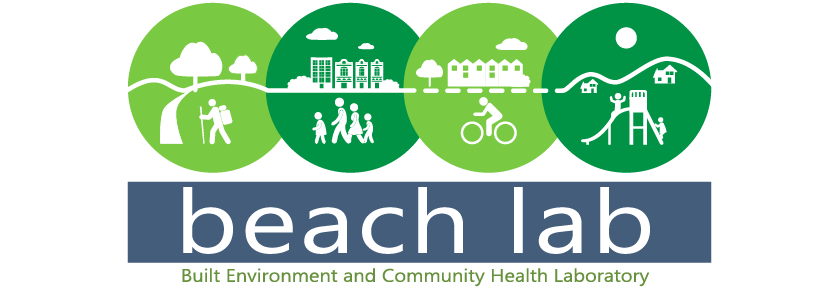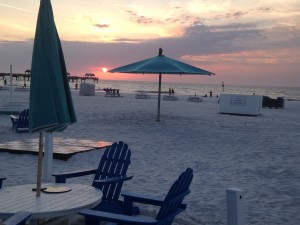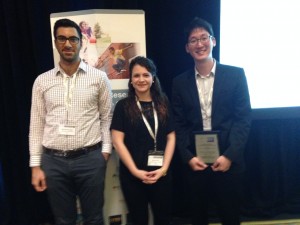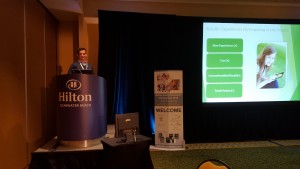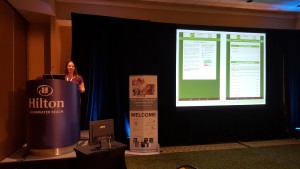Wow! What a conference! From Sunday, January 31st through Wednesday, February 3rd, the BEACH Lab had the privilege of attending and presenting at the 2016 Active Living Research Annual Meeting in Clearwater Beach, Florida. The theme of the conference was ‘Equity in Active Living’, which started with an invigorating talk by NiCole Keith where she discussed differences in equality and equity and gave some great examples of how equity in Active Living was being implemented in Indianapolis. Throughout the rest of the week, many recent projects from the BEACH Lab were shared in various presentation formats.
On Monday afternoon, Melissa Fair, a first-year doctoral student in the BEACH Lab, presented the evaluation findings from Park Hop 2014 titled ‘An interagency collaboration to promote park usage, discovery, and physical activity’ at the poster session. Evaluation of the Park Hop 2014 intervention showed significant increases in park usage and proportion of time spent in physical activity among youth who participated. This poster presentation was voted ‘best poster’ by colleagues attending the conference!
The poster session also featured great work from a few colleagues from the Department of Exercise Science at the University of South Carolina, including Morgan Clennin, Glenn Weaver, and Allison Randel. Similarly, an incoming student to the Health Promotion, Education, and Behavior doctoral program and BEACH Lab, Ellen Wenders from the University of Georgia, presented her Master’s research project titled ‘Community walkability and population health status: A study of Georgia counties.’ We are all excited to have Ellen join the BEACH Lab this Fall!
On Tuesday morning, Morgan Hughey, a third-year doctoral student in the BEACH Lab, gave a presentation titled, “Green and lean: Is neighborhood park and playground availability associated with youth obesity? Variations by gender, socioeconomic status, and race/ethnicity”. Results from this project showed that neighborhood park and playground availability was related to lower BMI for females, and several of the observed associations varied depending on race/ethnicity and SES. Morgan gave another presentation on Wednesday morning that focused on her work with LiveWell Greenville and the collaboration and initiatives of the ‘At Play’ workgroup. Throughout the conference, Morgan felt there were many great opportunities to network among diverse professionals in the field. She had the most fun playing beach volleyball with colleagues. Her team developed their name, South Baltipegs, from the places they were from/represented: South Carolina, Baltimore, and Winnipeg!
Later on Tuesday, Dr. Andy Kaczynski gave a presentation in the 8-minute speed session titled “Relationship of objective neighborhood quality attributes with youth physical activity: Findings from the Healthy Communities Study”. His presentation described how improved quality of specific attributes of youths’ home street segments were associated with greater neighborhood-based physical activity, especially in lower SES communities. In addition to his presentation, Andy organized a ‘parks happy hour’ that was attended by over 40 researchers and practitioners who came together informally to discuss current interests and future collaborations related to parks and active living.
On Wednesday, the last day of the conference, the BEACH Lab had two oral presentations that highlighted findings from the recent eCPAT project. Dr. Gina Besenyi, currently a new assistant professor at Augusta University (formerly Georgia Regents University), first presented her research titled “Development and testing of mobile technology for community park improvements: Validity and reliability of the eCPAT application with youth”, where she described main findings from her dissertation research project. Overall, she found that the mobile version of the eCPAT was valid and reliable and that youth preferred using the mobile app technology for conducting park audits.
In the same session, David Gallerani, who just completed his Master’s in Public Health degree, also presented recent findings from another component of the eCPAT project. His presentation was titled “’We actually care and we want to make the parks better’: Youth experiences, changes and perceptions as community advocates”. It focused on the qualitative arm of the eCPAT project where youth who participated in the park audits described their experiences participating in the project, changes they experienced as a result of participation, how information from the CPAT and eCPAT tools could be used, and whom they saw as potential users of the tools.
In the opening session of the conference, Jim Sallis challenged all of the conference attendees to step outside of their normal comfort zone to meet between 20-30 new people throughout the four days of the conference. At first, one would think there would be no way to accomplish that goal, but after the first day, it became clear that ALR provided an atmosphere conducive for this type of networking. The conference provided an open environment to meet a diversity of professionals from a variety of disciplines, including public health, urban planning, and parks and recreation. Maybe it was the sunny, white beaches that were right outside of the conference walls that created this unique atmosphere, but it was evident that this group was comprised of outstanding researchers and practitioners really trying to create a culture of active living.
Until next time!
